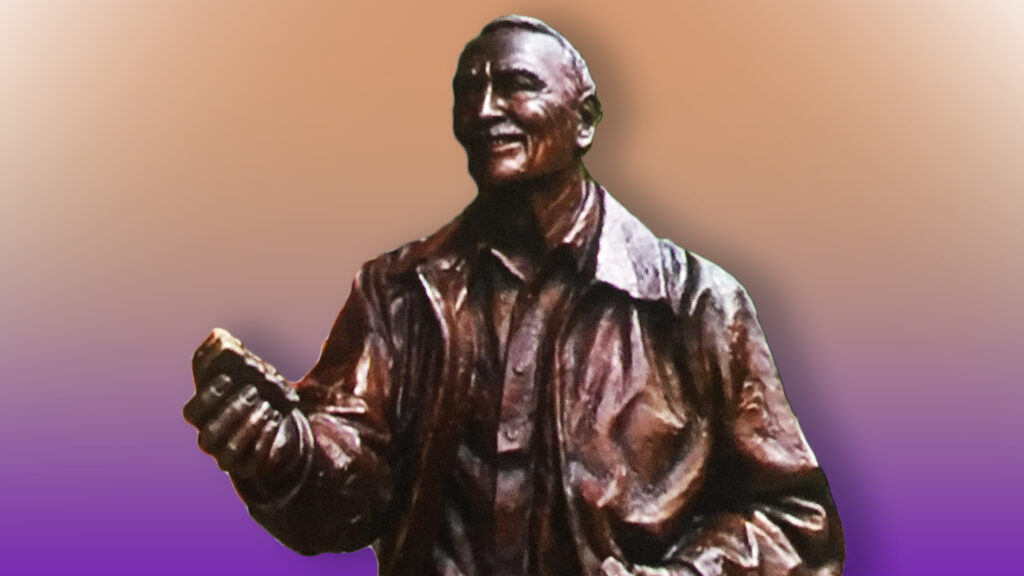
Outside a homeless shelter in Nashville, there was a statue of an elderly man holding a peanut butter and jelly sandwich. The bronze figure’s hand was outstretched with the sandwich, almost as if he was handing it to me. His golden smile told me that it was a friendly gesture. It was the middle of summer, and beads of sweat raced down my face. A PB&J sandwich sure would be nice right about now, I thought to myself.
I had just had a meeting with Charles Strobel, the founder of the shelter, when we walked outside to the front porch where the statue rested. Our conversation withered, as my eyes kept glancing over to the statue of the man with the sandwich. Charles noticed that I was eyeing the statue, and then asked, “Is he giving, or receiving?”
The question didn’t register with me. “What do you mean?” I said.
“Is he offering you the sandwich, or are you offering him the sandwich?”
To which my reply was, “Uhhhh . . .” (My first instinct would tell me that the man was offering me the sandwich.)
I waited for Charles to give me the answer. He didn’t. Instead, he moved on to the next conversation, as if the previous one had finished. But in my head, I was still trying to figure it out.
It wasn’t until later that I realized there were no wrong answers. The man, in my eyes, was happy to do a good deed and give me the sandwich. In others’ eyes, the man might have been happy to be receiving the sandwich. This told me that the answer was based on perspective, much like the proverbial Is the glass half full or half empty question. There were no right answers, like I learned. But there was, however, one emerging theme that encapsulated the scene: Sharing.
The plaque cemented into the brick wall next to the statue only amplified Charles’s question to me. In uppercase gold lettering:
This figure represents every man, woman and child . . . whose heart is moved to share. For in the sharing of gifts, time, and talents, relationships are formed, nurtured, and grown. When there is such sharing, equality emerges among us. One becomes both the giver and the receiver. And as the figure suggests, it is impossible to tell the difference. [Emphasis mine.]
Room in the Inn — Nashville, TN
Leaving the homeless shelter that day, I was dumbfounded. Speechless, rather. It was as if I had witnessed a whole new perspective on life, simply by the happenstance that I landed right next to the statue on my way out the door. I would never know for sure if the statue was giving me the bronze PB&J sandwich, or if I had just given him the bronze PB&J sandwich. But that wasn’t the point.
The point was this: When we share things, we are a community. Notice the statue still had a smile regardless of the outcome. (I mean, let’s be honest—it was permanent!) That was proof that sharing—the power of giving and receiving—worked both ways.
The statue served as a symbol of care. When we give to others, we feel a sense of warmth in our hearts. When others give to us, we again feel a sense of warmth in our hearts. It’s a two-fold occurrence that often goes overlooked in our busy lives.
How do we continue this narrative of sharing? For one, we must realize that sharing comes in many forms. Like the plaque said, sharing comes in “gifts, time, and talents.” We must also realize that a simple, small gesture goes a long way.
Back to the statue. We understand that this PB&J made a man smile, regardless of if it was given or received. Think: That man (the statue) could be homeless, and we just gave him his only meal for the day. Or, the opposite: the man saw us struggling and wanted to give us a gift. The possibilities were endless, and the statue served as a beautiful reminder of that.
It is in the sharing of ourselves that we make the world a difference. And if you’re in doubt about how to start, consider Charles Strobel’s words of wisdom: “Never underestimate the power of a peanut butter and jelly sandwich.”